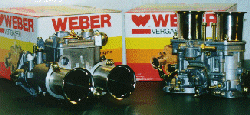

Make sure that the CHOKE lever is pushed in fully.
Check that the choke cable is allowing the enrichment levers on the back of the Webers return to their stops. Loosen the clamps with a 7mm wrench and push the levers to their stops. Tighten the clamp screws.
Check the FUEL HOSES for cracks (especially near the ends) or leaks.
Empty the water separator and inspect or replace the FILTER.
Check for FULL THROTTLE OPENING.
Have a helper step on the accelerator pedal while you watch the throttle shafts rotate to the fully open position. Adjust the linkage, if necessary. Make sure that the bellcrank under the carbs is not sticking on its shaft.
Synchronizing the throttles.
Make sure that the throttles are synchronized. Remove the brass plug (above the off-idle holes) of each carburetor section. Shine a flashlight into each of the holes to see that the edge of each throttle plate is aligned with the same hole when the throttle is slightly open. Adjust the spring-loaded screw in the linkage between the two Webers. Make sure that the Idle Stop Screw is NOT against its stop when you are making the adjustment or you will be even more confused.
Check the FLOAT LEVEL.
Remove some fuel from the carbs and let the engine idle for two minutes. Remove the wingnut caps.
Use the depth gauge end of vernier caliper to measure from the top of the lower shelf to the top of the fuel surface.
DCOE spec = 1.14 inch (29mm+4.5mm).
If the depth is NOT correct, the top plate of the carburetor must be removed. Carefully bend the tab on the float assembly that touches the needle valve. Reassemble and test the float level as before.
Check for Air leaks
Check for Intake System AIR LEAKS while engine is running Wiggle the carbs and pour water on the donuts and listen for a change in the engine speed.
Adjust the IDLE MIXTURE.
Raise the idle speed to 1000-1500 rpm by turning the Idle Stop Screw. Stop the engine. Remove the spark plug wires from the two rear spark plugs and ground the wires. Turn each of the front two Idle Mixture Screws clockwise and count the number of turns until the Idle Mixture Screw touches its seat. Normally, this screw is about 3/4 of a turn from its seat.
Restart the engine. Adjust the two front idle mixture screws so that the engine rpm is the highest possible. Allow a few seconds after each adjustment for the engine to respond to the change.
Stop the engine. Reconnect the two rear plug wires, disconnect, and ground the two front plug wires. Adjust the two rear idle mixture screws.
NOTE: The idle speed should be the same when the engine is running on the front two or on the rear two barrels.
Stop the engine and reconnect the wires. Turn the Idle Stop Screw clockwise to the original position. Start the engine.
Adjust the IDLE SPEED.
Adjust the idle speed by turning the Idle Stop Screw. If the idle is too high when the Idle Stop Screw is NOT touching its seat, the throttles are NOT returning to the closed position. Make sure that the linkage is not binding.